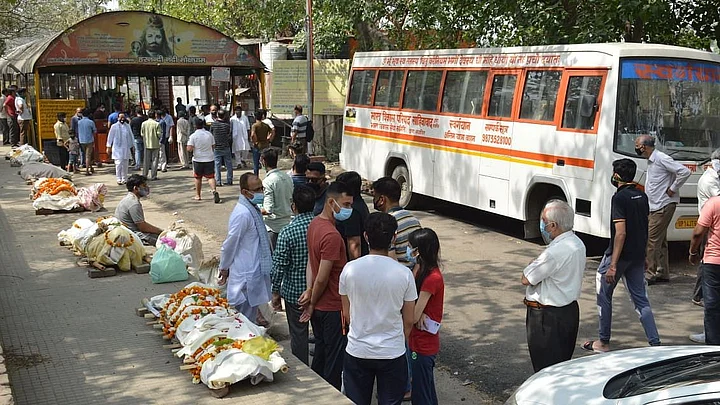Even as Uttar Pradesh Chief Minister Yogi Adityanath claimed on Monday, 26 April, that COVID-19 positive cases have gone down in the state, several districts in the state continue to fight more then 10,000 active cases.
After the state faced a similar oxygen and ICU bed crisis like Delhi, the state government finally announced some new measures on Sunday, 25 April, to tackle the situation.
Among other things, as per the new guidelines, if patients are unable to get treated in government hospitals for shortage of beds, they will be treated in private hospitals, with the government reimbursing the full cost of the treatment. Simultaneously, COVID hospitals will also have to update the number of beds available twice a day.
But all these measures came only after the health infrastructure was severely strained in the state, leading to the death of critical patients for want of timely treatment, while the state government continued to stay in denial.
Here’s everything COVID-related that Uttar Pradesh found itself in the news for, before the state government decided to take stock of the situation.
No Admission Without CMO Letter
The state had mandated the necessity of a referral from the CMO, who heads the Integrated Command and Control Centres set up by the government, for admission to hospitals. This would prove to be a hurdle for critical patients who need immediate medical attention.
After a journalist Vinay Srivastava died whilst live tweeting about his condition, as he failed to secure an admission without the CMO letter, even as his oxygen levels dropped, this contentious decision was reviewed by the state.
The mandatory referral will now no longer be required for admission at private hospitals.
Alleged Underreporting Of Cases
It has been widely alleged that the Adityanath government has been underreporting cases and deaths related to COVID-19, even as reports from the state point to a deadly situation in the state.
In fact, analytical reports suggest a mismatch in the official figure of deaths related to COVID-19 and the death count at crematoriums, triggering this scrutiny about the government figures.
In the case of Lucknow, while the cumulative death count was recorded at 124 in the seven days proceeding 15 April, the city's crematoriums recorded over 400 deaths in the same period.
Elsewhere in Varanasi, while the official record on 13 April reported only three deaths, an analytical report found that there were at least nine bodies cremated at just one of the crematoriums in the city.
Or take the case of Ghaziabad, which reported only two COVID-19 related deaths till 19 April. However, videos accessed by The Quint indicated a clear mismatch between the official figures and the ground reality.
Allegation of Cap on Private Lab Testing
As the number of cases shot up in Lucknow from 935 on 1 April to 5,511 on 18 April, there had also been complaints of COVID-19 testing being stopped at multiple private labs initially. This despite the fact that the chief minister had directed for the tests to be ramped up across the state.
When The Quint spoke to eight branches of SRL and Lal Path Lab in Lucknow to investigate into the claims of tests not being done, the labs stated that they had received orders from the top brass to not conduct any tests.
However, Lucknow’s Chief Medical Officer denied such allegations claiming that private labs had conducted 35 percent of the tests carried out in the city.
But later on 21 April as more such allegations came up from Ghaziabad and Gautam Buddha Nagar as well, the UP government said that “vested interests” were trying to spread rumours, whille adding that no district administration could stop private laboratories from testing.
Certain testing centres in Noida were reported to have added more hurdles for tests by making local ID cards mandatory for COVID tests. As a result, the urban migrant working population found it difficult to get tested.
A State in Denial
As it had been reported earlier that much like Delhi, Uttar Pradesh hospitals too are struggling to treat patients over a scarcity of oxygen in the state.
However on 25 April, CM Adityanath said, “There is no shortage of oxygen in any COVID hospital, be it private or government.”
Moreover, he announced that the state would be invoking the National Security Act (NSA) against “anti-social elements” who spread “rumours” and propaganda on social media and try to “spoil the atmosphere”.
The Chief Minister attributed the “real problem” behind the oxygen shortage to “hoarding and black marketing” and even claimed that certain hospitals that had reported a shortage of oxygen were later found to have enough oxygen.
But despite these assertions by the CM, it was reported that oxygen shortages in the state continued to affect COVID patients. Some hospitals in Gorakhpur, which is CM Adityanath’s constituency was also reported to be low on oxygen supply.
However recently, after a review meeting on oxygen shortage, the government announced it would get the consumption, sale and purchase of medical oxygen audited in collaboration with IIT-Kanpur, IIM-Lucknow, and IIT-BHU to ensure judicious use of oxygen.
Additionally, CM Aditynath also directed senior officials to ensure that oxygen plants are set up at 39 hospitals and 855 community health centres (CHCs) as soon as possible.
(At The Quint, we question everything. Play an active role in shaping our journalism by becoming a member today.)
